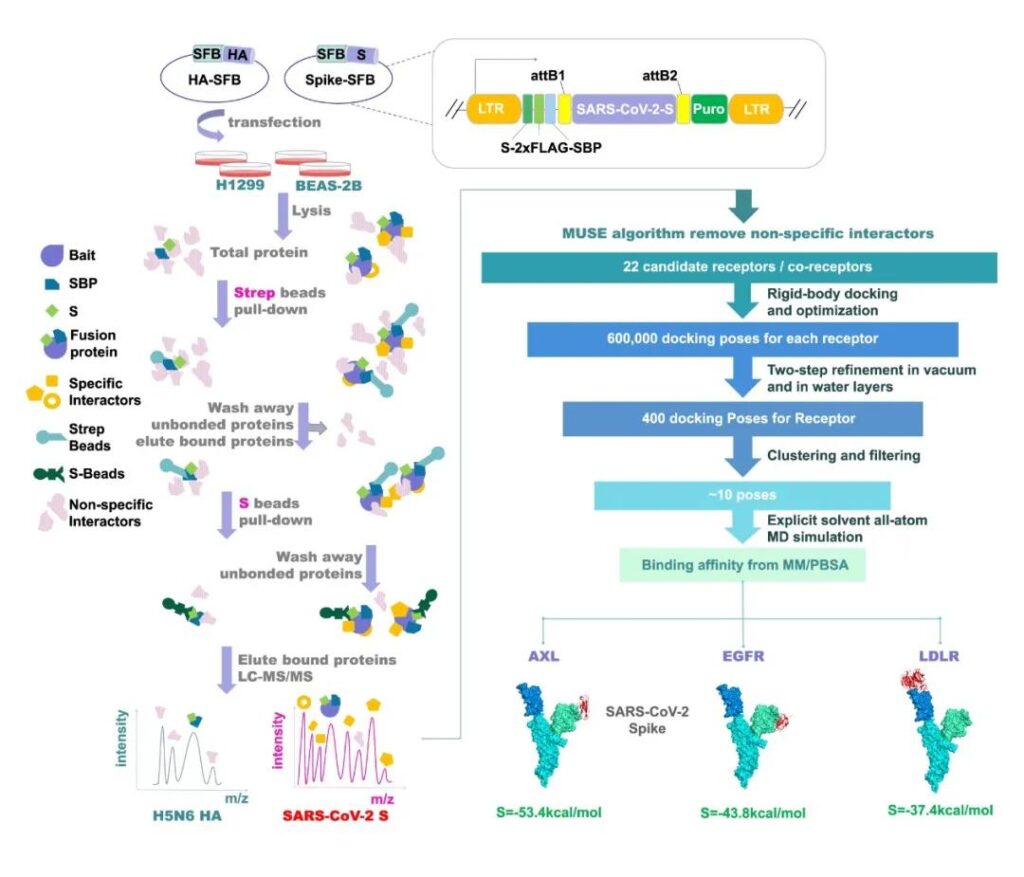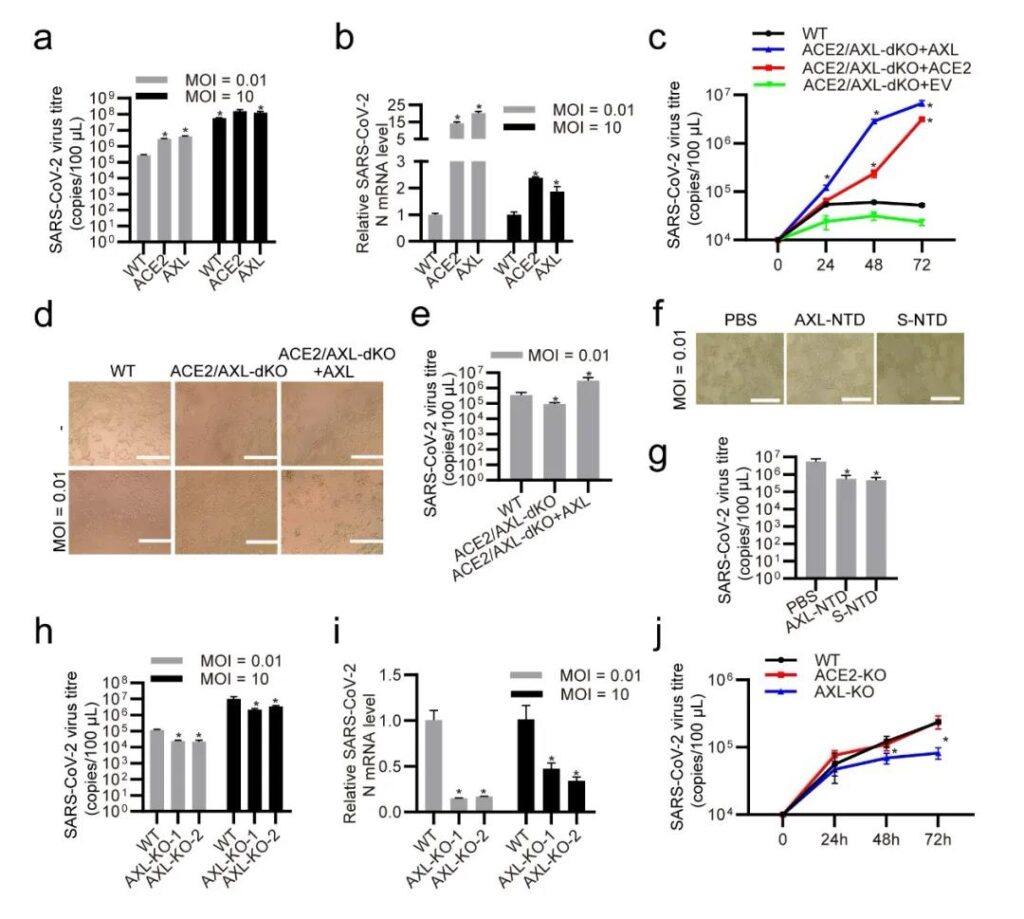AXL is a potential receptor of COVID-19 infection
- Normal Liver Cells Found to Promote Cancer Metastasis to the Liver
- Nearly 80% Complete Remission: Breakthrough in ADC Anti-Tumor Treatment
- Vaccination Against Common Diseases May Prevent Dementia!
- New Alzheimer’s Disease (AD) Diagnosis and Staging Criteria
- Breakthrough in Alzheimer’s Disease: New Nasal Spray Halts Cognitive Decline by Targeting Toxic Protein
- Can the Tap Water at the Paris Olympics be Drunk Directly?
AXL is a potential receptor of COVID-19 infection
AXL is a potential receptor of COVID-19 infection. West Lake University research team found that AXL is a potential receptor for the new coronavirus to infect the human respiratory system.
In 2020, the new coronavirus epidemic will spread globally, posing a challenge to human society. An in-depth understanding of the mechanism of new coronavirus infection, replication and immune escape is of great significance to the fight against the new coronavirus epidemic.
After the new type of coronavirus (SARS-CoV-2) infects the human body through the upper respiratory tract, the virus will gradually spread down the respiratory tract, causing severe lung inflammation. Virus replication and spread mainly rely on the interaction of virus surface spike protein with host cell surface receptors. The main receptor for the new coronavirus to invade the human body is the same as the SARS virus, ACE2. However, in the single-cell sequencing results, the expression of ACE2 in the respiratory system is low, and it is difficult to explain why the new coronavirus mainly infects the human respiratory system. Therefore, finding out the cell receptors of the new coronavirus in the human respiratory system and designing targeted drugs is of great significance for the prevention and treatment of the new coronavirus.
Recently, the Li Xu research group and Huang Jing research group of West Lake University cooperated with the land research group of Fudan University to jointly publish the title AXL is a Candidate Receptor for SARS-CoV-2 that Promotes Infection of in the Cell Research magazine. Pulmonary and Bronchial Epithelial Cells research paper 1.
Paper link:
https://www.nature.com/articles/s41422-020-00460-y
image
The study found that the AXL protein is a potential receptor for the new coronavirus to infect the human respiratory system. This is also the first new receptor for the new coronavirus that does not depend on ACE2.
Distinguished researchers Li Xu and Huang Jing from the School of Life Sciences of West Lake University and Fudan University researcher Lu Lu are the corresponding authors of this paper. West Lake University Wang Shuai, Qiu Zongyang, Hou Yingnan, Deng Xiya and Fudan University Xu Wei are the co-first authors of this paper. Zhou Qiang of West Lake University, Shan Chao of Wuhan Institute of Virology, Chinese Academy of Sciences, Lin Aifu and Sun Zewei of Zhejiang University, Jiang Shibo and Xie Youhua of Fudan University, and Fudan University’s biosafety protection third-level laboratory Qu Di and Cai Xia are also involved in this research Provided important support. This project was funded by the National Natural Science Foundation of China, the Natural Science Foundation of Zhejiang Province, and the West Lake Education Foundation.
Speculation: The new coronavirus has other important receptors in the human respiratory system
By analyzing large-scale human single-cell sequencing data, the research team found that ACE2 is mainly expressed in the human kidney and digestive system, but only in about one-thousandth of lung cells and two-thousandth of tracheal cells. Such a low level of ACE2 expression cannot support the high infectivity of the new coronavirus in the population, so the research team speculated that the new coronavirus may have other important receptors in the human respiratory system.
By conducting pseudovirus infection experiments on some commonly used cell lines carrying the new coronavirus spike protein, it was found that the lung epithelial cell line H1299 and the bronchial epithelial cell line BEAS-2B can be infected, so the research team used these two cell lines for follow-up Screening of new coronavirus receptors.
Combining proteomics, bioinformatics, and computational biology methods, the research team constructed a stable transgenic cell line of the viral spike protein, affinity purification, mass spectrometry identification, and used the Minkowski high-dimensional distance developed by the laboratory. The MUSE algorithm selected 22 candidate receptors. Through molecular dynamics simulation and molecular mechanics/Poisson-Boltzmann surface area calculations, a series of simulation calculations were performed on the complexes formed by these candidate receptors and the new coronavirus spike protein, and the top three binding strengths were finally screened Candidate receptors: AXL, EGFR and LDLR.

Confirmed: the new coronavirus can use the host’s AXL protein to invade the respiratory system
Through a series of biochemical and cellular experiments, the research team proved that the AXL protein on lung cells binds to the new coronavirus spike protein and has a strong co-localization on the cell membrane. Interestingly, AXL does not bind to the spike protein used to bind to the RBD region of ACE2, but instead binds to the NTD region at the N-terminus of the spike protein, which is in line with the antagonistic spike protein N previously discovered by Zhou Qiang and his team of West Lake University in patients with COVID-19 The end of the antibody is confirmed2. At the same time, analysis found that AXL is highly expressed in almost all types of respiratory cells including lung type I/II epithelial cells, basal cells, fibroblasts, endothelial cells, smooth muscle cells and myeloid cells.
AXL is a receptor tyrosine kinase that is located on the cell membrane. It is a protein in the human body that mediates the transduction of extracellular signals of PI3K and other signaling pathways into the cell. It is widely involved in regulating cell survival, proliferation, Migration and differentiation. Its name derives from the Greek word “out of control”. It was first discovered in patients with chronic myeloid leukemia and may be involved in the occurrence of cancer.
The new coronavirus spike protein pseudovirus infection experiment found that overexpression of AXL in HEK293T can significantly enhance virus infection. Subsequently, the research team conducted experiments such as pseudovirus adsorption, internalization, and co-localization of endocytic vesicle transport markers, and further clarified that AXL mediates the adsorption and co-localization of the virus on respiratory cells by specifically binding to the new coronavirus spike protein. Internalization. Therefore, AXL may be a potential receptor for the new coronavirus on lung cells.
The research team subsequently discovered that the knockout of AXL can significantly reduce the infection of H1299 cells by the pseudovirus. In order to rule out the possibility of AXL helping ACE2 to mediate viral infection, the research team constructed an ACE2 or/and AXL knockout H1299 cell line, and found that knocking out ACE2 had no effect on virus infection of H1299 cells, while knocking out AXL significantly reduced Fake virus infection. Adding synthetic soluble AXL recombinant protein to cell culture media can effectively inhibit virus infection of H1299 cells. At the same time, the research team found that ACE2 and AXL do not have a cross-infectious inhibitory function, suggesting that AXL may be a new receptor for the new coronavirus that does not depend on ACE2.

Outlook: Drugs designed based on AXL may be used for intervention of COVID-19 pneumonia
After clarifying that AXL can bind to the new coronavirus spike protein in the form of a receptor to mediate the entry of pseudoviruses, the research team conducted a true virus infection experiment of the new coronavirus in a third-level biosafety protection laboratory. The experimental results show that AXL can independently mediate the infection of the new coronavirus without relying on ACE2. After double knockout of ACE2 and AXL proteins in 293T cells, overexpression of AXL alone can promote viral infection, while the addition of AXL recombinant protein or new coronavirus spike protein NTD recombinant protein can inhibit AXL-mediated viral infection, confirming AXL-mediated new coronavirus infection does not depend on ACE2. The research team further knocked out AXL in lung epithelial organoids formed by the lung epithelial cell line H1299 and normal lung epithelial cells, and found that the new coronavirus infection was significantly inhibited. Adding soluble AXL recombinant protein or new coronavirus spike protein NTD recombinant protein can also greatly inhibit viral infection. Finally, the research team confirmed that in patients with COVID-19, the expression of AXL is highly correlated with viral load and disease progression.
In this study, the research team built a protein interaction network of the new coronavirus spike protein in human lung epithelial cells by integrating proteomics, bioinformatics, and computational biology techniques, and identified the AXL protein as a lung and Potential receptor in tracheal epithelial cells. Subsequent studies have found that overexpression of AXL can effectively promote the invasion of new coronaviruses, while knocking out AXL in human lung epithelial cells significantly reduces new coronavirus infections. At the same time, clinical data from patients with COVID-19 also show that AXL expression levels are highly correlated with severe infections. The use of soluble AXL protein can effectively antagonize the infection of lung cells by the new coronavirus, suggesting that drugs targeted or designed based on AXL may be used for future clinical interventions against new coronavirus infections. It is worth noting that new variants of viruses that can escape antibodies or vaccines recently discovered in the United Kingdom, South Africa and other places have dense mutations near the AXL binding region on the spike protein3. Can the mutant viruses more effectively use AXL to invade humans? The respiratory system needs further study.
(source:internet, reference only)
Disclaimer of medicaltrend.org



